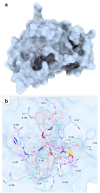This is a preprint.
Polymorphic Structure Determination of the Macrocyclic Drug Paritaprevir by MicroED
- PMID: 37781611
- PMCID: PMC10541134
- DOI: 10.1101/2023.09.09.556999
Polymorphic Structure Determination of the Macrocyclic Drug Paritaprevir by MicroED
Update in
-
Polymorphic Structure Determination of the Macrocyclic Drug Paritaprevir by MicroED.Adv Biol (Weinh). 2024 May;8(5):e2300570. doi: 10.1002/adbi.202300570. Epub 2024 Feb 21. Adv Biol (Weinh). 2024. PMID: 38381052 Free PMC article.
Abstract
Paritaprevir is an orally bioavailable, macrocyclic drug used for treating chronic Hepatitis C virus infection. Its structures had been elusive to the public until recently when one of the crystal forms was solved by MicroED. In this work, we report the MicroED structures of two distinct polymorphic crystal forms of paritaprevir from the same experiment. The different polymorphs show conformational changes in the macrocyclic core, as well as the cyclopropylsulfonamide and methylpyrazinamide substituents. Molecular docking shows that one of the conformations fits well into the active site pocket of the NS3/4A serine protease target, and can interact with the pocket and catalytic triad via hydrophobic interactions and hydrogen bonds. These results can provide further insight for optimization of the binding of acylsulfonamide inhibitors to the NS3/4A serine protease. In addition, this also demonstrate the opportunity of deriving different polymorphs and distinct macrocycle conformations from the same experiments using MicroED.
Keywords: CryoEM; HCV Protease; Macrocycles; MicroED; Molecular Chameleons; Polymorphism.
Figures



References
-
- Byrn S.R., et al. Solid-State Pharmaceutical Chemistry. Chem. Mater. 1994, 6(8), 1148–1158.
-
- Lu J., Rohani S.. Polymorphism and crystallization of active pharmaceutical ingredients (APIs). Curr. Med. Chem. 2009, 16(7), 884–905. - PubMed
-
- Morissette S.L. et al. High-throughput crystallization: polymorphs, salts, co-crystals and solvates of pharmaceutical solids. Adv. Drug Deliv. Rev. 2004, 56(3), 275–300. - PubMed
-
- Cruz-Cabeza A.J., Bernstein J.. Conformational Polymorphism. Chem. Rev. 2014, 114(4), 2170–2191. - PubMed
Publication types
Grants and funding
LinkOut - more resources
Full Text Sources
